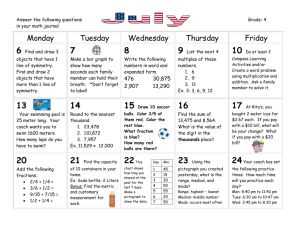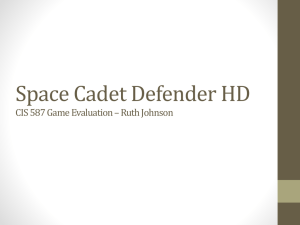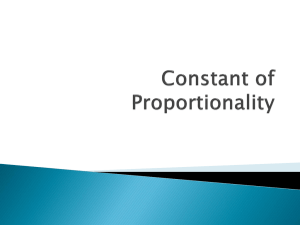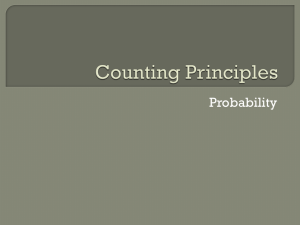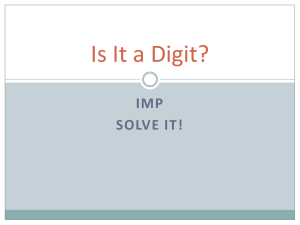solution for Junior Maths Olympiad
advertisement
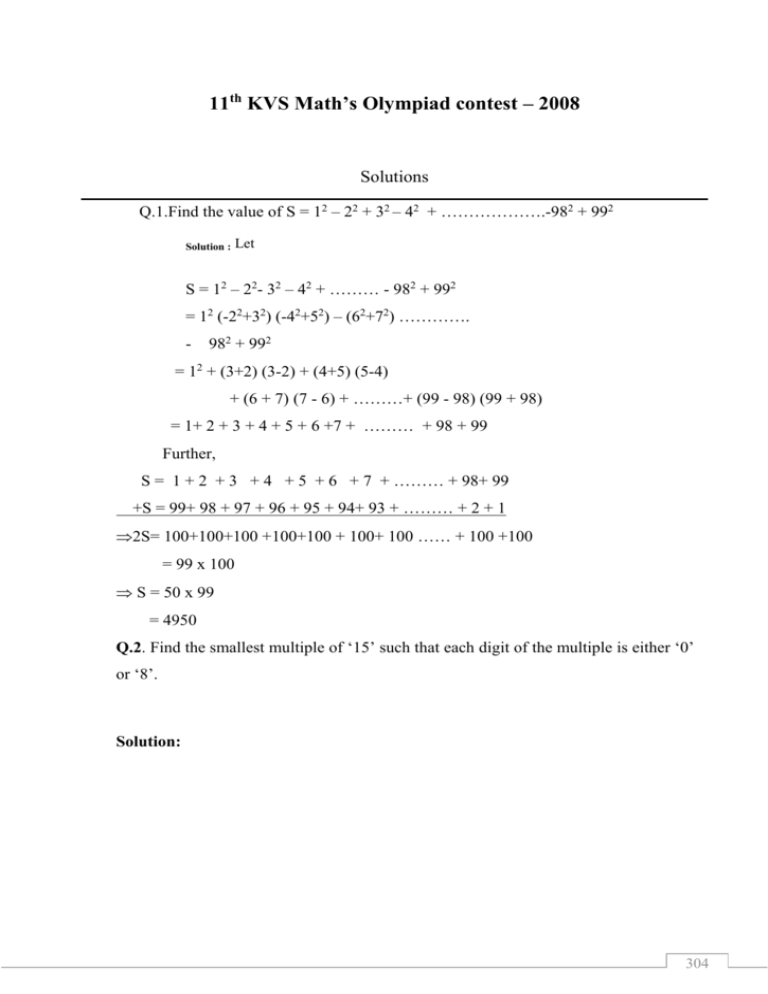
11th KVS Math’s Olympiad contest – 2008 Solutions Q.1.Find the value of S = 12 – 22 + 32 – 42 + ……………….-982 + 992 Solution : Let S = 12 – 22- 32 – 42 + ……… - 982 + 992 = 12 (-22+32) (-42+52) – (62+72) …………. - 982 + 992 = 12 + (3+2) (3-2) + (4+5) (5-4) + (6 + 7) (7 - 6) + ………+ (99 - 98) (99 + 98) = 1+ 2 + 3 + 4 + 5 + 6 +7 + ……… + 98 + 99 Further, S = 1 + 2 + 3 + 4 + 5 + 6 + 7 + ……… + 98+ 99 +S = 99+ 98 + 97 + 96 + 95 + 94+ 93 + ……… + 2 + 1 2S= 100+100+100 +100+100 + 100+ 100 …… + 100 +100 = 99 x 100 S = 50 x 99 = 4950 Q.2. Find the smallest multiple of ‘15’ such that each digit of the multiple is either ‘0’ or ‘8’. Solution: 304 Smallest multiple of 15, such that each digit of the multiple in either 0 or 8 are Two & Three digit nos Four digit and Five digit nos 80 8000 880 8008 808 8080 800 8800 8880 80888 80888 88088 So only possibility for multiple of 15 i.e. divisible by 5 is last digit is 0 i.e. (i) 2 digits 80 (ii) 3 digits 880, 800 (iii) 4 digit s (iv) 5 digit 8000, 8800, 8880, 8080 88880 80000 88800 88000 88080 As 15 = 5x3 So the number should be divisible by 3 the sum of digit should be divisible by 3. Hence let us analyze the sum of digits in (i), (ii), (iii) and (iv), (i) 2 digit : not possible (ii) 3 digit : not possible (iii) 4 digit : with 888 sum in 8+8+8 = 24 305 that is divisible by 3 But last digit should be 0 and it should contain three numbers of 8. i. e. 8880 Q. 3 At the end of year 2002. Ram was half as old as his grandfather. The sum of years in which they were born is 3854. What is the age of Ram at the end of year 2003? Let age of Ram at the end of 2002 = x so age of his grand father = 2x so, Ram was born in (2002 - x) Ram’s grand father was born in (2002-2x) from question : 2002 – x + 2002 – 2x = 3854 -3x = - 150 x = 50 So, the age of Ram at the end of 2003 in 51. Q. 4 Find the area of the largest square, which can be inscribed in a right angle triangle with legs ‘4’ and ‘8’ units. Solution: Let the side of square is x as in figure. 4-x 4 x x x x 8-x 8 From property of similar triangle 4-x = x x 8-x 306 (4-x) (8-x) = x2 32 – 4x - 8x + x2 = x2 32 = 12x x= 8 3 = 2.67 so Area of largest square in 64 sq units 9 =7 1 sq units. 9 Q.5. In a Triangle the length of an altitude is 4 units and this altitude divides the opposite side in two parts in the ratio 1:8. Find the length of a segment parallel to altitude which bisects the area of the given triangle. Solution: Let the triangle is ABC an in figure A E h B D C F x t 8x-t AD = 4 unit BD = x DC = 8 x Let EF = h and DF = t 1 2 307 So Area ABD = X 4 X x = 2x 1 X 9x X 4 = 18x 2 Area ABC = Let EF bisect the area of ABC, and EF║AD So, area EFC = 9x = 1 X(8x-t) X h 2 h= 18 x 8x - t ………….(1) The area of ADFE 1 X(AD+EF) X t 2 1 = 2 X (AD + EF) X t = = (9x – 2x) [i.e. half area – area ABD of triangle] = 7x 1 7x= 2 X (4+h) X t t = 14x h+4 ..…………..(2) putting t form (ii) in (i) 18x = (8x - t) = 8x – 18 = 8x – 14x h+4 14x h+4 h h 8 (h = 4) – 14 h+4 308 18 = 18 (h + 4) = [8 (h+4) - 14] h 18 h + 72 = [8h + 32 - 14] h h = [8 h + 18] h = 8 h2 + 18 h 8 h2= 72 h2 = 72 8 = 9 h=3 so, height = 3 units Ans. Q.6 A number ‘X’ leaves the same remainder while dividing 5814, 5430, 5958. What is the largest possible value of ‘X’? Solution: Let p, q, r and s be any number from the question, if r in remainder. 5814 = p X + r …………………. (i) 5430 = q X + r …………………. (ii) 5958 = s X + r ………………….. (iii) from (i) & (ii) 384 = (p-q) X from (ii) & (iii) 5430 – 5958 = (q - s) X 309 528 = (s - q) X from (iii) & (i) 5814 – 5958 = (p - s) X 144 = (s - p) X so we get three equation 384 = (p - q) X 528 = (s - q) X 144 = (s - p) X (p - q) X = 2x2x2x2x2x2x2x3 (s - q) X = 2x2x2x2x x3x 11 (s - q) X = 2x2x2x2x x3x x3 So the HCF of these three numbers = 2x2x2x2x3 = 48 So the required largest number is 48 Check: 48 x 121 = 5808 then + 6 = 5814 48 x 113 = 5424 then + 6 = 5430 48 x 124 = 5952 than + 6 = 5958 Q.7. A sports meet was organized for four days. On each day, half of existing total medals and one more medal was awarded. Find the number of medals awarded on each day. Solution: Let total medals = m Medals distributed on m 2 m+2 +1 = 2 310 1st day = Remaining medals for 2nd day = m – [medals distributed on 1st day] = m- m-2 2 = m-2 2 So, medals distributed on 2nd day m+2 = +1 4 m+2 = 4 Remaining medals for 3rd day = m – [medals distributed or 1st + 2nd day] =m– m+2 2 m+2 + 4 m-6 = 4 So, medals distributed on 3rd day 311 = m-6 +1 8 = m+2 8 Remaining medals for 4th day = m – [medals distributed on 1st + 2nd + 3rd day] m+2 = = m– 2 m+2 m+2 + 4 + 8 m + 14 8 So, medals distributed on 4th day m - 14 = = 16 +1 m+2 16 So Final remaining medals after distribution on 4th day = m – [medals distributed on 1st+2nd + 3rd + 4th day] m 2 m 2 m 2 m 2 m 4 8 16 2 m 15m 30 16 312 But sport end & hence methods remained = 0 16 m = 15m + 30 m = 30 So day wise medal distribution Day 1 = 16 Day 2 = 8 Day 3 = 4 Day 4 = 2 1) Total = 30 Q.8. Let ΔABC be isosceles with ABC = ACB = 780. Let D and E be the points on sides AB and AC respectively such that BCD = 240 and CBE = 510. Find the angle BED and justify your result. Solution: A 24 . 51 D 78 B 78 51 24 78 C From question AB = AC So BDC = 180 – (24+78) = 780 and DBC = 780 So BC = DC 313 Further, BEC = 180 – (78+51) = 51 So BC = EC = DC Let DEB = x, So in isosceles CED, CDE = CED = 51+x Let BE and CD meet at F So DFE = 1050 Hence in Δ DFE 51+x + 105 + x = 1800 2x = 24 x = 120 Justification C D E = 51+12 = 63 Hence EDA = 180 – (78+63) = 39 Hence , AED = 180 – (24+39) = 1170 so 117 + 12 + 51 = 1800 Hence justified 314


